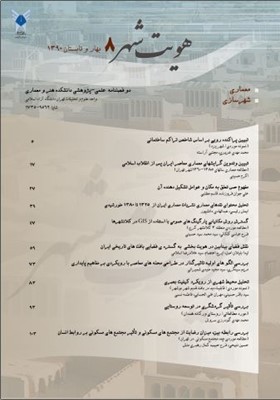نقش فضای بینابین در هویت بخشی به گستره ی فضایی بافتهای تاریخی ایران
محورهای موضوعی : معماریلیدا بلیلان اصل 1 , ایرج اعتصام 2 , سید غلامرضا اسلامی 3
1 - استادیار دانشگاه آزاد اسلامی، واحد تبریز، گروه هنر و معماری، تبریز، ایران
2 - استاد دانشکده معماری، پردیس هنرهای زیبا، دانشگاه تهران
3 - دکتر سید غلامرضا اسلامی، استادیار دانشکده معماری، پردیس هنرهای زیبا، دانشگاه تهران.
کلید واژه: Iranian Architecture, بینابینی, فضای بینابین, Historical Context, بافتهای تاریخی, گسترۀ فضائی معماری ایران, : In between- Space, In between,
چکیده مقاله :
در بافتهای تاریخی شهرهای کهن ایرانی فضاهای رابطی با شکل، کارکرد ومعانی متعدد میان عناصر مختلف وجود داشته است که عامل مهم پیوند فضائی عناصر معماری و شهری به یکدیگر با هویتی واحد محسوب می شده است. در این رابطه هدف از ارائۀ این مقاله شناسایی و تعیین نقشِ فضاهای بینابین در هویت بخشی به گسترۀ فضائی بافت های تاریخی ایران است. بر اساس تحقیقات انجام شده، فضای بینابین نقش سازماندهی اجزاء و عناصر را در هر بنا و فضای شهری بر عهده داشته و ظرفی برای عملکردهای مختلف محسوب می شده است.لذا چنین فضاهایی به واسطه اهداف سازنده اش ماهیت دو وجهی یافته، هم فرآیند و هم محصولِ فرآیند می باشد. فضای بینابین هم زمان با فرایند شکل دادن، به درجه بندی و جهت گیری مفاهیم متمایز نیز کمک می نماید و از این طریق در نهایت کلی واحد ظهور می نماید
Lida Balilan Asl (Email:lidabalilan@iaut.ac.ir) , Ph.D, Department of Art and Architecture, Science and Research Branch, Islamic Azad University, Tehran, Iran. Iraj Etesam,Ph.D, Professor, Faculty of Architecture, University of Tehran. Seyed Gholamreza Islami,Ph.D, Assistant Professor, Faculty of Architecture, University of Tehran. The research and topical purpose of this thesis is first to determine the characteristics of in-between space, then to recognize these spaces in the context of the architecture and finally to identify their role in the spatial organization of urban and architectural elements. One of the major problems in the fabric of most cities in the world, is the crisis in the identity of urban and architecture. The physical display of the identify crisis in the cities is the spatial separation of the architectural and urban elements, in the particular and whole scales. As to the claim of this thesis, an ignorance of the connective and in-between spaces is an important and impressive factor in the physical identity crisis of the historical fabrics. To obtain the mentioned objectives and to prove the hypothesis of the thesis, a phenomenological approach and historical analysis method are used to analyze the content of the texts. The theoretical basis of the thesis is founded on the researches on the various aspects of the space and on the concepts which are influential on setting limiting borders and defining the architectural spaces and consequently the in-between spaces which are analyzed according to the structural content analysis as well as analysis-comparison. Due to its nature, the in-between space has some various spatial and meaningful characteristics. This quality has caused the in-between characteristics to be expressed in terms of three forms of formal-physical, meaning-functional and connective-geometrical. Therefore, the relation and interaction of the functions require a third space between the interior and exterior spaces (in & out). Moreover the conceptual focus, the functional interaction and the formal distinguish, imply a fencing of the interior space through a threshold which allows a relation and connection with the outer space. This threshold not only determines and controls the domain and ownership, but it also plays the role of reception, interpretation, improvise and change of the information. The threshold as a distinguishing, connecting and relating factor through the transition field, intervenes in the space organization. This impact can well be observed through determining of the formation features and elements, the pattern of relationship and the discipline dominant over the relations in terms of some organizational principles such as spatial hierarchy. The obtained results suggest that the in-between space due to its constructive objectives takes on an equivocal nature. It becomes both the process and the product. Thus, it contributes to the formation process in order that a unified whole should emerge; it also helps simultaneously the concepts be classified and take orientation. Therefore, in a rotational movement the in-between space influences the spatial organization through its impact on the basics and principles. On the other hand, through its spatial features such as space relations, the spatial organization is influential in the development and evolution of the in-between spaces. The result emphasizes on the comprehensibility of the in-between spaces in the various urban and architectural scales, and consequently it puts emphasis on the significance of the in-between spaces as the major factors in the spatial organization.
_||_

